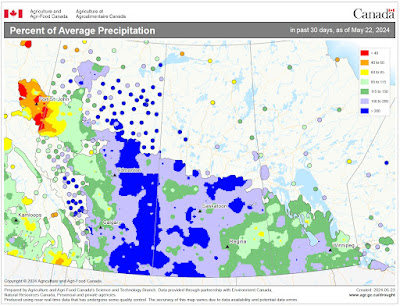The spring of 2024 started dry in some Prairie regions, but recent rains have resulted in improved moisture conditions for crop establishment and subsequent development. Most of the Prairies have 30 day rainfall amounts were normal to above normal (Figure 1). Cumulative rainfall has been greatest along the Alberta-Saskatchewan border and across southern regions of Manitoba, Saskatchewan and Alberta. Total rainfall (mm) over the past 30 days was 64 mm and was 233% of climate normal values. So far, rainfall amounts in 2024 are much greater than last year. In 2023, rain for April 20 to May 19 was 48% of normal. This is good news for farmers, but moist conditions can elevate disease risk. Moisture can increase the risk of seed and seedling disease issues, early season root infections, and facilitate pathogen fruiting body and spore development. As we move into June this moisture can increase the risk of subsequent canopy disease development, and thus the potential need for fungicide application for foliar disease management in cereals and pulses. Staying on top of rapidly emerging disease issues such as leaf spots and rusts can be challenging during a very busy growing season.
Figure 1. Percent of average precipitation on the Prairies over the past 30 days as of May 22, 2024.
To help facilitate awareness of developing plant disease issues on a regional- and prairie-wide basis, the Prairie Crop Disease Monitoring Network (PCDMN) and the three Prairie provincial pathologists have worked with colleagues from the Agriculture and Agri-Food Canada (AAFC) Geomatics Group since summer 2021. The result of this collaboration is the development and deployment of the Prairie Crop Disease Monitoring Network Quick Disease Reporter Tool (PCDMN QDRT).
The PCDMN QDRT can be used to make quick general reports of diseases in common crops over the Prairie region as part of the Prairie Crop Disease Monitoring Network. These reports will be used to prepare PCDMN QDRT disease update maps. Initially our target is to provide bi-weekly map updates. The maps will be shared via the PCDMN Blog and PCDMN Twitter feed as well as via provincial government or producer group crop/disease updates during the summer. PCDMN QDRT reports will aid in identifying regions where disease outbreaks are starting to occur. This information provides a timely heads-up for producers and crop consultants indicating where further in-crop scouting and risk assessment are needed, especially when a fungicide application is being considered for foliar disease management. Please note the success of the PCDMN QDRT is dependent on farmer, consultant/agronomist, researcher and producer group/provincial extension staff participation. The greater the number of reports, the better able we are to inform individuals and organizations regarding emerging disease issues so they can take appropriate and timely actions.
A tutorial for the installation and use of the PCDMN QDRT can be found here: PCDMN QDRT tutorial (Spring 2023 version).
Please consider installing the PCDMN QDRT app (used in conjunction with the Survey 123 app) on your smartphone and contributing your field crop disease observations as we move into June and July. The PCDMN respects individual farmer’s and consultant’s privacy concerns. All QDRT submissions are made on a municipality basis for each Province without having to provide specific field location information.
Associated with the use of the PCDMN QDRT is the need to take digital photographs of symptoms when scouting crops. In addition, farmers and crop consultants may share these images with consultants, provincial plant disease specialists, plant pathology researchers, producer group extension coordinators, and industry representatives to request a digital diagnosis. In July 2023, the PCDMN posted a tutorial on digital diagnosis, which highlighted some of the more common mistakes that can be made when taking pictures of disease symptoms. Included in the PCDMN blog article are tips to improve your plant disease photos, which will help facilitate the ability to digitally diagnose issues during the growing season. The blog article can be accessed here: Say cheese: digital photos and effective plant health diagnostics!


